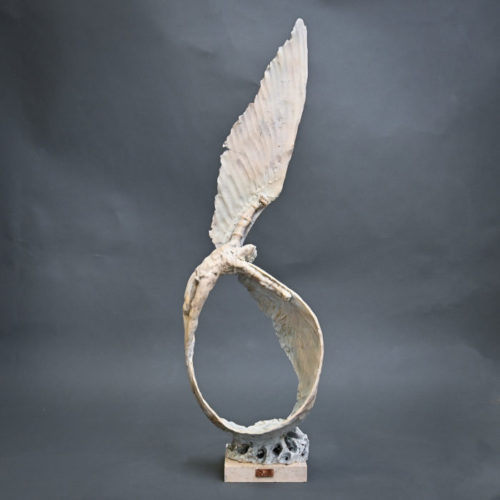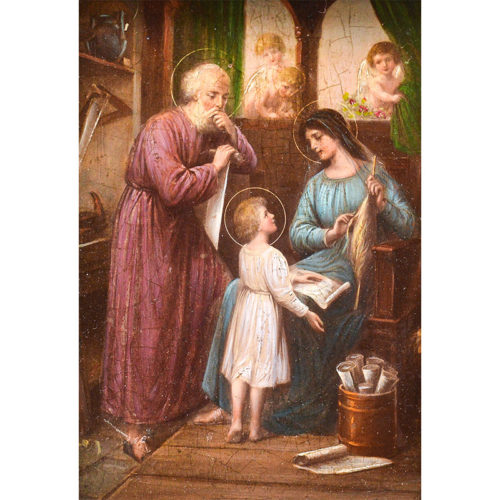-
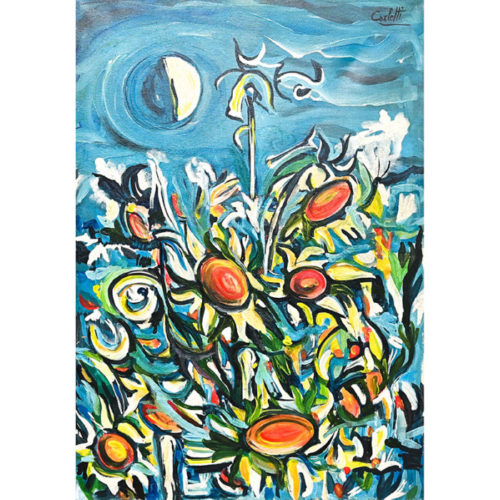 "Flowers and Moon" Oil on canvas by Mario Carletti from the 60s / 70s. Carletti Mario (Turin 1912 - Cossato 1977), a Piedmontese painter and engraver, he painted views, landscapes, portraits and works of sacred art. He exhibited at the Venice Biennale in 1942 and at the Rome Quadriennale in 1956. Period: 60s / 70s Measurements: H 100 x W 70 x D 2 cm
"Flowers and Moon" Oil on canvas by Mario Carletti from the 60s / 70s. Carletti Mario (Turin 1912 - Cossato 1977), a Piedmontese painter and engraver, he painted views, landscapes, portraits and works of sacred art. He exhibited at the Venice Biennale in 1942 and at the Rome Quadriennale in 1956. Period: 60s / 70s Measurements: H 100 x W 70 x D 2 cm -
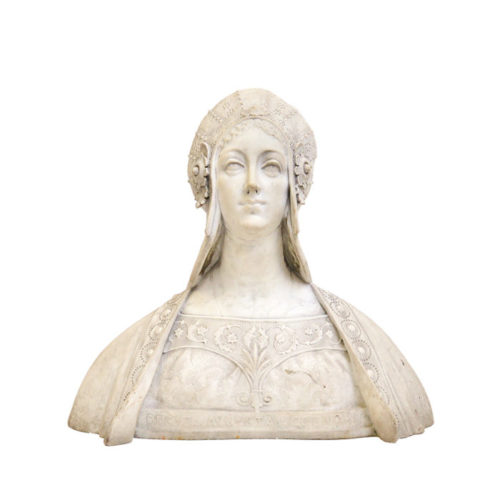 "Florentine noble lady " - Ancient Italian marble from the second half of the 19th century. Tuscan half-bust of exquisite workmanship depicting a noble Florentine lady. Perfectly finished in detail. It bears the inscription"Decus Augusta Coenobili". In good state of conservation and beautiful patina.Period: Second half of the 19th century Measurements: H 66 x W 78 x D 30 cm
"Florentine noble lady " - Ancient Italian marble from the second half of the 19th century. Tuscan half-bust of exquisite workmanship depicting a noble Florentine lady. Perfectly finished in detail. It bears the inscription"Decus Augusta Coenobili". In good state of conservation and beautiful patina.Period: Second half of the 19th century Measurements: H 66 x W 78 x D 30 cm -
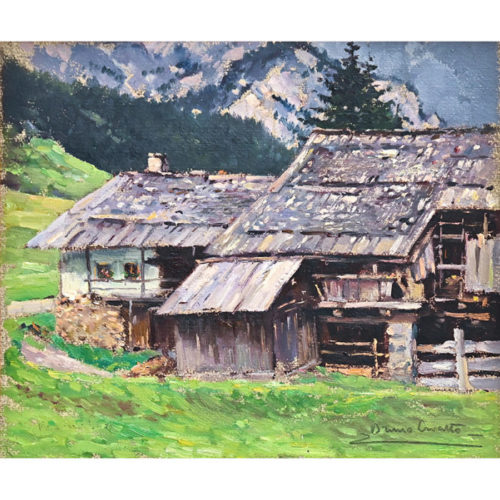 "Fontanazzo in Val di Fassa, Trentino" by Bruno Croatto (1875-1948), oil on cardboard signed on the lower right and titled on the back. Without frame. He was born in Trieste on April 12th, 1875. In the years 1891-1892 he was a disciple of Gabriel Hackl at the Academy of Munich: but he studied the Impressionists outside school, and eventually the great masters of the fifteenth century. He worked on figures, landscapes, flowers, but from 1908 he emerged in etching and aquatint, in which, neglecting the drawing, he sought only colorist effects and chiaroscuro. He exhibited in Munich, Trieste, Paris, Venice, Rome, Milan, London, Prague, Vienna. In 1930 he held a solo exhibition at the Chamber of Artists in Rome, with many paintings and etchings. Some of his works are kept in the Uffizi Gallery; at the Revoltella Museum in Trieste; in public collections in New York and in England. Period: early 1900s Measurements: H 28 X L 33 cm
"Fontanazzo in Val di Fassa, Trentino" by Bruno Croatto (1875-1948), oil on cardboard signed on the lower right and titled on the back. Without frame. He was born in Trieste on April 12th, 1875. In the years 1891-1892 he was a disciple of Gabriel Hackl at the Academy of Munich: but he studied the Impressionists outside school, and eventually the great masters of the fifteenth century. He worked on figures, landscapes, flowers, but from 1908 he emerged in etching and aquatint, in which, neglecting the drawing, he sought only colorist effects and chiaroscuro. He exhibited in Munich, Trieste, Paris, Venice, Rome, Milan, London, Prague, Vienna. In 1930 he held a solo exhibition at the Chamber of Artists in Rome, with many paintings and etchings. Some of his works are kept in the Uffizi Gallery; at the Revoltella Museum in Trieste; in public collections in New York and in England. Period: early 1900s Measurements: H 28 X L 33 cm -
Out of stock
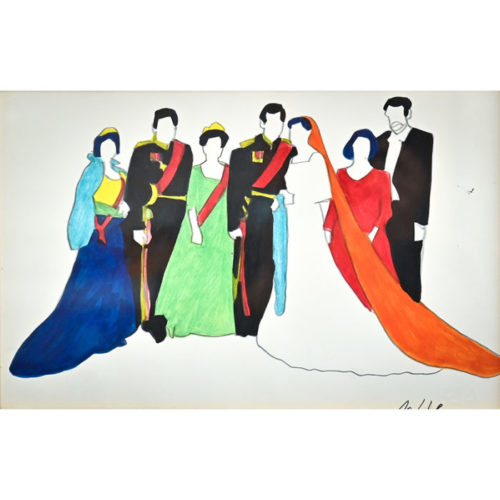 "Foto ricordo" marker pen by Marco Lodola. Signed at lower right, dating from the 1980s, on the back is labeled by Galleria Arte Rotaross and Galleria Arte Antico Borgo. Authentication by the artist on a photo. Period: the 1980s Measurements: In frame H 38 x W 49 x D 4 / H 22 x W 32 cm
"Foto ricordo" marker pen by Marco Lodola. Signed at lower right, dating from the 1980s, on the back is labeled by Galleria Arte Rotaross and Galleria Arte Antico Borgo. Authentication by the artist on a photo. Period: the 1980s Measurements: In frame H 38 x W 49 x D 4 / H 22 x W 32 cm -
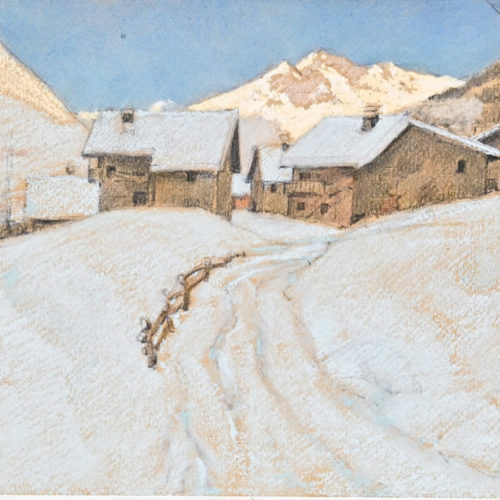 Carlo Musso (1907 - 1968), gracious chalk on paper by the Turinese artist. Signed on the lower right, dating back to the 1940s. Born on September 7th 1907 and dead on September 25th 1968 in Turin. He attended the Albertina Academy of Fine Arts along with the masters Luigi Onetti, Cesare Ferro and later on with Guido di Montezemolo. This last artist was his companion with whom he had learned to dig into the true soul of the Piedmontese landscapes, pictorically describing it with a deep sense of lyricism. He participated in the main Italian group exhibitions: Circolo degli Artisti, Arbarello prize with the work 'Ponte sulla Dora' (1946); CAI Award, silver medal with 'Preludio di tormenta' (1947); Black and White exhibition, medal of silver San Paolo with Strada del fortino (1952); City of Chieri competition, first prize with "the Duomo, evening" (1953); International Self-portrait Exhibition, silver medal (1956); Circolo degli Artisti of Turin, Follini prize with "Porto di Savonasotto la neve" (1958); Alessandria Commerce Award, first prize with "Casale Market" (1962); Pragelato Narcisi in fiore competition, first prize (1966); Exhibition of Floral compositions at Valentino, gold medal ( 1966); City of Cumiana painting exhibition, first prize and gold medal with "Autumn in Val di Susa" (1966) He has set up personal exhibitions in various Italian cities. Measurements: W 35 x H 22,5
Carlo Musso (1907 - 1968), gracious chalk on paper by the Turinese artist. Signed on the lower right, dating back to the 1940s. Born on September 7th 1907 and dead on September 25th 1968 in Turin. He attended the Albertina Academy of Fine Arts along with the masters Luigi Onetti, Cesare Ferro and later on with Guido di Montezemolo. This last artist was his companion with whom he had learned to dig into the true soul of the Piedmontese landscapes, pictorically describing it with a deep sense of lyricism. He participated in the main Italian group exhibitions: Circolo degli Artisti, Arbarello prize with the work 'Ponte sulla Dora' (1946); CAI Award, silver medal with 'Preludio di tormenta' (1947); Black and White exhibition, medal of silver San Paolo with Strada del fortino (1952); City of Chieri competition, first prize with "the Duomo, evening" (1953); International Self-portrait Exhibition, silver medal (1956); Circolo degli Artisti of Turin, Follini prize with "Porto di Savonasotto la neve" (1958); Alessandria Commerce Award, first prize with "Casale Market" (1962); Pragelato Narcisi in fiore competition, first prize (1966); Exhibition of Floral compositions at Valentino, gold medal ( 1966); City of Cumiana painting exhibition, first prize and gold medal with "Autumn in Val di Susa" (1966) He has set up personal exhibitions in various Italian cities. Measurements: W 35 x H 22,5 -
Out of stock
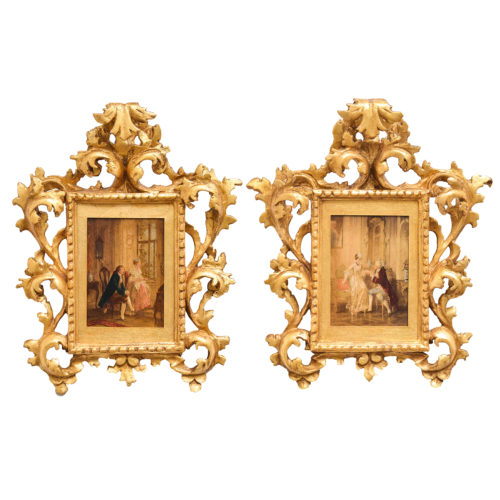 Period: Second half of the 19th century Measurements: In frame H 38 x L 30 / Tablet H 15 x L 11,5 cmPair of gallant scenes, retouché by Otto Wilhelm Eduard Erdmann (7 December 1834, Leipzig - 9 December 1905, Düsseldorf) He was a German genre painter in the Rococo Revival style. The retouché technique uses a print as a base, but thanks to hand-made retouches and finishes, it returns a physical and external appearance similar to a completely painted picture.
Period: Second half of the 19th century Measurements: In frame H 38 x L 30 / Tablet H 15 x L 11,5 cmPair of gallant scenes, retouché by Otto Wilhelm Eduard Erdmann (7 December 1834, Leipzig - 9 December 1905, Düsseldorf) He was a German genre painter in the Rococo Revival style. The retouché technique uses a print as a base, but thanks to hand-made retouches and finishes, it returns a physical and external appearance similar to a completely painted picture. -
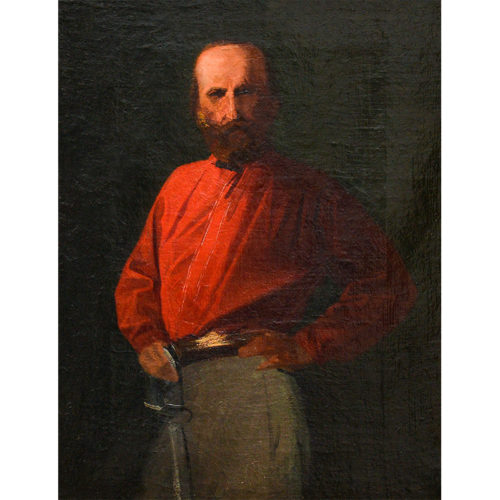 Period: 19th century Measurements: H 50 x L 41 x P 4.5 / Canvas H 39 x L 31 cm"Garibaldi" - Oil on canvas by Teofilo Patini (1840-1906) PATINI TEOFILO. Born in Castel di Sangro (L'Aquila) on May 5, 1840, died in Naples on November 16, 1906. He moved to Naples at a very young age, after graduating in Fine Arts; he enrolled at the Institute of Fine Arts, where Filippo Palizzi was teaching at the time. During the courses he easily won several prizes and finally obtained a pensioner to go to Rome, where he studied deeply the ancient masters and in particular those of the seventeenth century. He also was strongly influenced from Dutch paintings, but, above all, it was the Meissonnier who conquered him. He first dealt, for a short period of time, with the historical picture; then, with his sensitive and scornful soul, as an attentive observer of the events of human life, he gave himself to social painting, expressed with a strong and meticulous verism. His masterpiece is L'erede, which was exhibited in Milan in 1881 and is now found in the Gallery of Modern Art in Rome with Spade and Milk, exhibited in Turin in 1884. Other important paintings of his are: Il Parmigianino; The sack of Rome, of the Municipality of Naples; Art and freedom; Salvator Rosa's studio, exhibited in Turin in 1880 and in Vienna; Every good boot becomes a slipper; The first riding lesson, which is owned by the baritone Titta Ruffo; Pack animals, sent to Venice in 1887; Rocky landscape, in the M.O. collection of Milan; The riding lesson, in the Borgogna Museum of Vercelli; The country doctor; Belly and heart; The company of death: After defeat; The good ones; The notables of my country; The eagle; The caralluccio; Return to the sheepfold; The chain. Patini also tried, with less success, the sacred subject, and the paintings are remembered in this regard: Gloria del Sacramento; The temptations of Saint Anthony; Christ in the garden; The Redeemer; Christ raises the widow's son; The Annunziata; Il Purgatorio: The Crucifix; The Guardian Angel; Sant'Antonio di Padova; San Carlo Borromeo. There are also the sketches for the decorations of the Aula Magna of the University of Naples (work that, for the artist's death, remained unfinished), and the frescoes in the hall of the City Council of the same city. His students include M. Dragonetti Cappelli, E. Rubei, Vittor Scarselli.
Period: 19th century Measurements: H 50 x L 41 x P 4.5 / Canvas H 39 x L 31 cm"Garibaldi" - Oil on canvas by Teofilo Patini (1840-1906) PATINI TEOFILO. Born in Castel di Sangro (L'Aquila) on May 5, 1840, died in Naples on November 16, 1906. He moved to Naples at a very young age, after graduating in Fine Arts; he enrolled at the Institute of Fine Arts, where Filippo Palizzi was teaching at the time. During the courses he easily won several prizes and finally obtained a pensioner to go to Rome, where he studied deeply the ancient masters and in particular those of the seventeenth century. He also was strongly influenced from Dutch paintings, but, above all, it was the Meissonnier who conquered him. He first dealt, for a short period of time, with the historical picture; then, with his sensitive and scornful soul, as an attentive observer of the events of human life, he gave himself to social painting, expressed with a strong and meticulous verism. His masterpiece is L'erede, which was exhibited in Milan in 1881 and is now found in the Gallery of Modern Art in Rome with Spade and Milk, exhibited in Turin in 1884. Other important paintings of his are: Il Parmigianino; The sack of Rome, of the Municipality of Naples; Art and freedom; Salvator Rosa's studio, exhibited in Turin in 1880 and in Vienna; Every good boot becomes a slipper; The first riding lesson, which is owned by the baritone Titta Ruffo; Pack animals, sent to Venice in 1887; Rocky landscape, in the M.O. collection of Milan; The riding lesson, in the Borgogna Museum of Vercelli; The country doctor; Belly and heart; The company of death: After defeat; The good ones; The notables of my country; The eagle; The caralluccio; Return to the sheepfold; The chain. Patini also tried, with less success, the sacred subject, and the paintings are remembered in this regard: Gloria del Sacramento; The temptations of Saint Anthony; Christ in the garden; The Redeemer; Christ raises the widow's son; The Annunziata; Il Purgatorio: The Crucifix; The Guardian Angel; Sant'Antonio di Padova; San Carlo Borromeo. There are also the sketches for the decorations of the Aula Magna of the University of Naples (work that, for the artist's death, remained unfinished), and the frescoes in the hall of the City Council of the same city. His students include M. Dragonetti Cappelli, E. Rubei, Vittor Scarselli. -
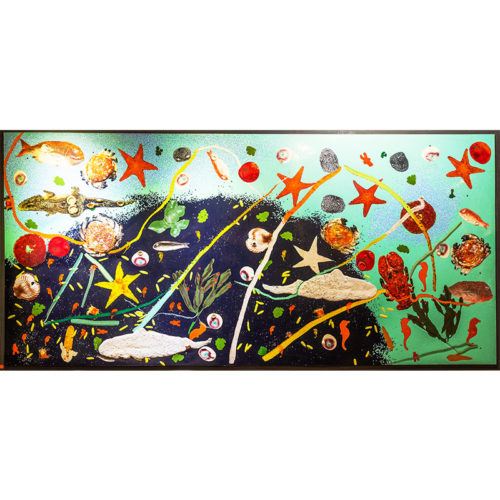 The most important work of Omar Aprile Ronda (Portula, 11 September 1947 - Biella, 7 December 2017), was an Italian artist, painter, sculptor, art collector and publisher. The work is published on the cover of the catalog "Genetic Fusions - Genetic Fusions" of 1991 of which a quote is reported below: "Genetic Fusions" are fascinating for their relation with the infinitely small, within which thousands of events take place and where order seems to be the highest law we are not allowed to know yet, but that the artist makes us perceive through imagination and poetry" The work is dated and signed on the back by the author who guarantees its authenticity. Period: 1990 Measurements: H 135 x L 281 cm
The most important work of Omar Aprile Ronda (Portula, 11 September 1947 - Biella, 7 December 2017), was an Italian artist, painter, sculptor, art collector and publisher. The work is published on the cover of the catalog "Genetic Fusions - Genetic Fusions" of 1991 of which a quote is reported below: "Genetic Fusions" are fascinating for their relation with the infinitely small, within which thousands of events take place and where order seems to be the highest law we are not allowed to know yet, but that the artist makes us perceive through imagination and poetry" The work is dated and signed on the back by the author who guarantees its authenticity. Period: 1990 Measurements: H 135 x L 281 cm -
Out of stock
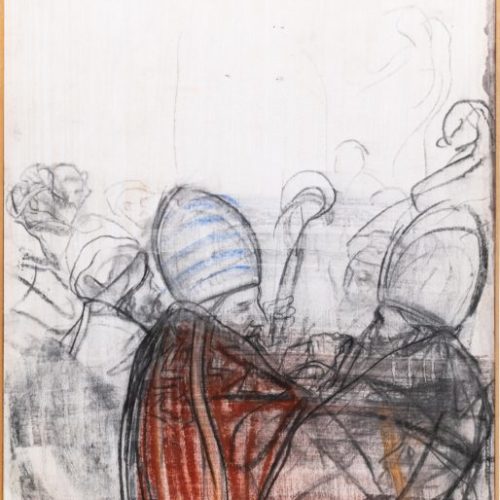 "Glory of St. Benedict" mixed media on paper by Pietro Annigoni (1910-1988), on the reverse side cartouche of the IInd Biennale of Sacred Art of Pescara. Measurements: In frame H 99.5 x W 78.5 x D 10 / Paper H 80 x W 60 cm
"Glory of St. Benedict" mixed media on paper by Pietro Annigoni (1910-1988), on the reverse side cartouche of the IInd Biennale of Sacred Art of Pescara. Measurements: In frame H 99.5 x W 78.5 x D 10 / Paper H 80 x W 60 cm -
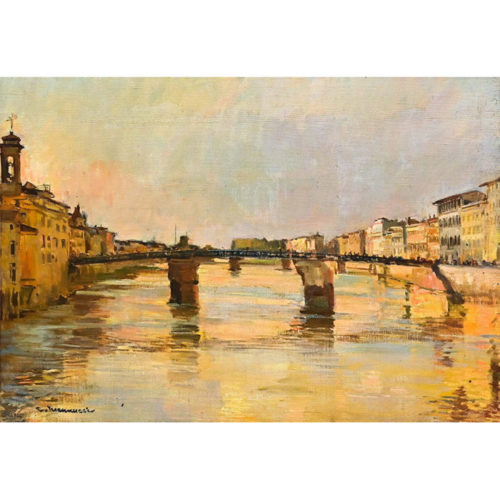 "Golden Light on the Arno' oil on canvas by Cipriano Antonio Mannucci (1882-1970). The work is from the 1940s. View of Florence from Ponte Vecchio, in the painting there are the 16th century Santa Trinità bridge, and the famous Basilica di Santo Spirito or Cappella del Brunelleschi on the left, while on the right the view is of the famous Lungarno degli Acciaiuoli. Period: 1940s Measurements: Framed H 74.5 x W 95 x D 8.5 / Canvas H 49.5 x W 70, 5 cm
"Golden Light on the Arno' oil on canvas by Cipriano Antonio Mannucci (1882-1970). The work is from the 1940s. View of Florence from Ponte Vecchio, in the painting there are the 16th century Santa Trinità bridge, and the famous Basilica di Santo Spirito or Cappella del Brunelleschi on the left, while on the right the view is of the famous Lungarno degli Acciaiuoli. Period: 1940s Measurements: Framed H 74.5 x W 95 x D 8.5 / Canvas H 49.5 x W 70, 5 cm -
Out of stock
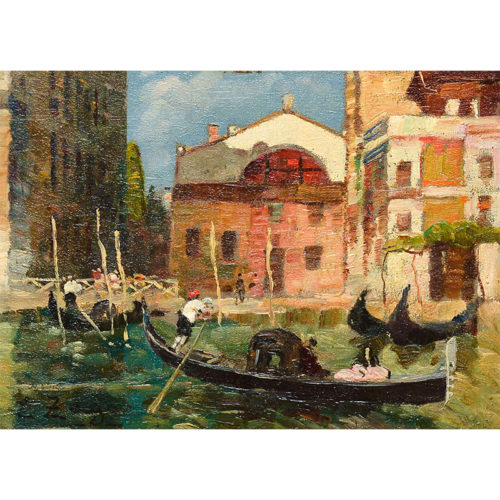 Gondolas in Venice, Erma Zago (1880-1942), oil on tablet, signed on the lower left, with a dedication on the back. Dating from the early 1900s.Period: Early 1900s Measurements: In frame H 39 x W 46.5 / Canvas on wood H 19 x W 26.5 cm
Gondolas in Venice, Erma Zago (1880-1942), oil on tablet, signed on the lower left, with a dedication on the back. Dating from the early 1900s.Period: Early 1900s Measurements: In frame H 39 x W 46.5 / Canvas on wood H 19 x W 26.5 cm -
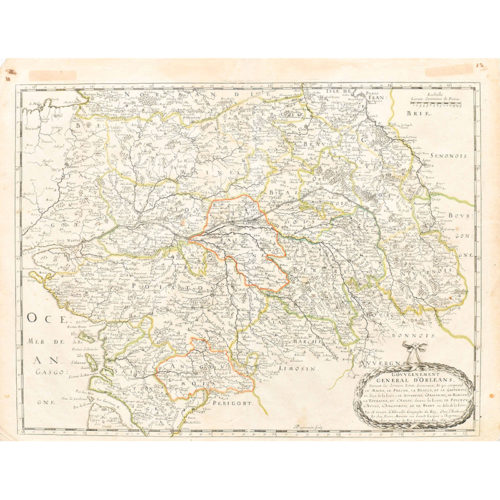 Beautiful example of the engraved map of Nicolas Sanson d'Abbeville from 1650. Nicolas Sanson (1600-1667), sometimes called Nicolas Sanson d'Abbeville or Sanson d'Abbeville, was the most important French cartographer of the 17th century. Tooley called Sanson "the founder of the French school of cartography". He started making cards at the end of 1620, and in 1630 he worked with Melchior Tavernier. Subsequently, Sanson worked in concert with the publisher Pierre Mariette, with whom he published his great atlas: general maps of all parts of the world (1658). After Sanson's death in 1667, his son Guillaume ran the business in collaboration with Alexis Hubert Jaillot. Guillaume has established himself as a full-fledged very important French cartographer.Period: 1650 Measurements: In frame H 65 X L 79 / Paper H 44 X L 56 cm
Beautiful example of the engraved map of Nicolas Sanson d'Abbeville from 1650. Nicolas Sanson (1600-1667), sometimes called Nicolas Sanson d'Abbeville or Sanson d'Abbeville, was the most important French cartographer of the 17th century. Tooley called Sanson "the founder of the French school of cartography". He started making cards at the end of 1620, and in 1630 he worked with Melchior Tavernier. Subsequently, Sanson worked in concert with the publisher Pierre Mariette, with whom he published his great atlas: general maps of all parts of the world (1658). After Sanson's death in 1667, his son Guillaume ran the business in collaboration with Alexis Hubert Jaillot. Guillaume has established himself as a full-fledged very important French cartographer.Period: 1650 Measurements: In frame H 65 X L 79 / Paper H 44 X L 56 cm -
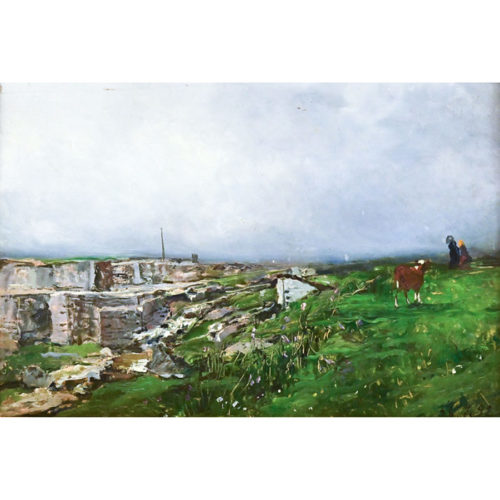 "Grey weather" oil on panel by Lorenzo Delleani. Original work by the artist from Biella, oil on panel 31 x 45 cm, with authentication by Bistolfi on the back and confirmation from the Archivio Pittori e Scultori Piemontesi. The painting depicts one of the frequent grey days of fog and rain around the Sanctuary of Oropa, more precisely in the meadow above the Sanctuary, where twenty years later the construction of the New Basilica of Oropa began. Period: 29/7/92 Measurements: In frame H 51,5 x W 65,5 x D 6,5 / Tablet H 31 x 45 cm
"Grey weather" oil on panel by Lorenzo Delleani. Original work by the artist from Biella, oil on panel 31 x 45 cm, with authentication by Bistolfi on the back and confirmation from the Archivio Pittori e Scultori Piemontesi. The painting depicts one of the frequent grey days of fog and rain around the Sanctuary of Oropa, more precisely in the meadow above the Sanctuary, where twenty years later the construction of the New Basilica of Oropa began. Period: 29/7/92 Measurements: In frame H 51,5 x W 65,5 x D 6,5 / Tablet H 31 x 45 cm -
Out of stock
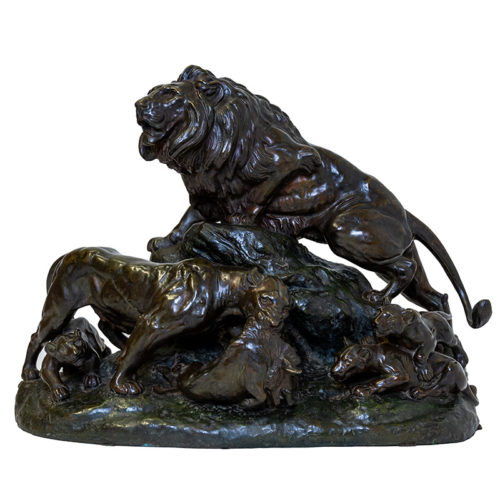 Beautiful bronze animal sculpture depicting a group of lions by Clovis Edmond Masson (1838, Paris - 1913). Signed by the author on the basement.Period: Second half of the 19th century Measurements: H 60 x L 46 x P 30 cm
Beautiful bronze animal sculpture depicting a group of lions by Clovis Edmond Masson (1838, Paris - 1913). Signed by the author on the basement.Period: Second half of the 19th century Measurements: H 60 x L 46 x P 30 cm -
Out of stock
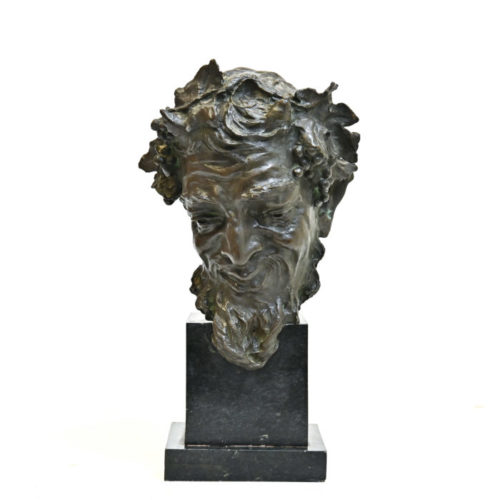 "Head of Satyr" - Bronze sculpture by Vincenzo Gemito (Naples, 16 July 1852 - Naples, 1 March 1929), Italian sculptor, designer and goldsmith. In Naples he was known as "’ o crazy sculptor " because he was tormented and marked by profound psychic imbalances; in reality his name was Vincenzo Gemito (Naples 1852 - 1929), a goldsmith and sculptor who, due to his condition, was often forced to take long breaks from his creative activity. His life was not simple right from the start: he was abandoned to his fate by his parents after being deposited in the wheel of exposures of the Annunziata plant. In fact, his real surname was Genito - "generated" - usually associated with orphans, but due to a mistake by a scribe the N became an M. Adopted and raised in a very poor family, from an early age Gemito proved to be gifted with immense talent for the plastic arts. His watchful eye loved to dwell above all on the scenes of the Neapolitan slums and his favorite subjects were children dressed in rags, commoners and players. The Gallerie d’Italia in Naples houses one of the most important nucleus of the artist's works, coming from the collection of the lawyer Gabriele Consolazio: terracotta, bronzes and drawings produced between the 1870s and the 1920s of the following century. The young heads modeled in terracotta - such as the impressive "Scugnizzo", "Fiociniere" and "Moretto" - testify to his tendency towards naturalism. Much more sophisticated are the bronze portraits of famous people, such as that of the Spanish painter Mariano Fortuny and his contemporary Domenico Morelli. His tireless plastic research is represented in particular by the "Philosopher's head" and the later "Neapolitan girl's bust", characterized by a sensual classicism that recalls the seductions and virtuosity of ancient Hellenistic sculpture. The drawings made with different materials and procedures are no less splendid: Gemito, in fact, knew how to master pencil, charcoal, ink, watercolor, sanguine and white tempera with the same skill. The engaging self-portraits are exhibited at Palazzo Zevallos Stigliano, merciless evidence of the painful changes in his physiognomy over the years; another important series on display consists of the figures of women where it is possible to observe the style research inspired by seventeenth-century models that made Vincenzo Gemito the last follower of Neapolitan naturalism.Period: '900 Measurements: H 42 x W 23 x D 23 cm
"Head of Satyr" - Bronze sculpture by Vincenzo Gemito (Naples, 16 July 1852 - Naples, 1 March 1929), Italian sculptor, designer and goldsmith. In Naples he was known as "’ o crazy sculptor " because he was tormented and marked by profound psychic imbalances; in reality his name was Vincenzo Gemito (Naples 1852 - 1929), a goldsmith and sculptor who, due to his condition, was often forced to take long breaks from his creative activity. His life was not simple right from the start: he was abandoned to his fate by his parents after being deposited in the wheel of exposures of the Annunziata plant. In fact, his real surname was Genito - "generated" - usually associated with orphans, but due to a mistake by a scribe the N became an M. Adopted and raised in a very poor family, from an early age Gemito proved to be gifted with immense talent for the plastic arts. His watchful eye loved to dwell above all on the scenes of the Neapolitan slums and his favorite subjects were children dressed in rags, commoners and players. The Gallerie d’Italia in Naples houses one of the most important nucleus of the artist's works, coming from the collection of the lawyer Gabriele Consolazio: terracotta, bronzes and drawings produced between the 1870s and the 1920s of the following century. The young heads modeled in terracotta - such as the impressive "Scugnizzo", "Fiociniere" and "Moretto" - testify to his tendency towards naturalism. Much more sophisticated are the bronze portraits of famous people, such as that of the Spanish painter Mariano Fortuny and his contemporary Domenico Morelli. His tireless plastic research is represented in particular by the "Philosopher's head" and the later "Neapolitan girl's bust", characterized by a sensual classicism that recalls the seductions and virtuosity of ancient Hellenistic sculpture. The drawings made with different materials and procedures are no less splendid: Gemito, in fact, knew how to master pencil, charcoal, ink, watercolor, sanguine and white tempera with the same skill. The engaging self-portraits are exhibited at Palazzo Zevallos Stigliano, merciless evidence of the painful changes in his physiognomy over the years; another important series on display consists of the figures of women where it is possible to observe the style research inspired by seventeenth-century models that made Vincenzo Gemito the last follower of Neapolitan naturalism.Period: '900 Measurements: H 42 x W 23 x D 23 cm
